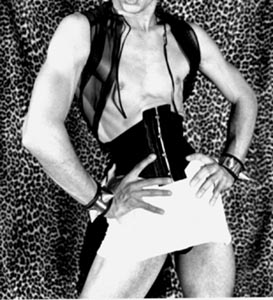![[MetroActive Features]](/metropolitan/gifs/feat468.gif)
[ Features Index | San Francisco | MetroActive Central | Archives ]
You've Come A Long Way, Baby!
A century of fashion innovation, novelty and faux pas
By Dara Colwell
While fashion largely remains in the eye of the beholder, clothing has always served its purpose--be it social, sexual, cultural or individual. Since man evolved from his naked-ape status (and because nudity is often perceived as a threat), he has cloaked himself in threads, accentuated this, minimized that, tucked those neatly away and managed to avoid sitting on cold surfaces unprepared. Now that we've arrived at the early 21st century, marked by a casual chic as disposable as our income, fashion will no doubt take new, unexpected turns. But one thing remains certain: Western fashion has gone through such rapid changes and bizarre extremes that looking back inevitably evokes morbid fascination.
What better time to start than at the turn of last century, which welcomed in La Belle Époque and America's fickle love affair with fashion. The popular figure at the time was the "Grecian bend"--a pigeon-breasted bosom, tiny corseted waist and full swayback hips. The corset, itself, had appeared in the late 19th century and caused considerable debate. The popular practice of tight-lacing and the inward-curving busk at the corset's front raised the question whether it was harmful to the wearer's health. (Pretty much a no-brainer. The fashion elite at the time probably coined the cliché "it ain't easy being pretty," as its members hit the floor gasping for air.) Dress was, of course, exceedingly formal and reflected social status. Little boys and girls were outfitted in delicate lace collars and fancy sailor suits, ladies wore high-boned collars and all skirts gracefully swept the floor.
The 1920s was a decade notorious for scandalous changes in fashion, drinking habits and Mafia activity. It was the era of sheiks and shebas, smart debutantes smoking with abandon in public, and the streamlined, curveless figure. Skirts fell sordidly short, between the knee and mid-calf depending on the season, and formal clothes hardly differed from casual ones. Clothing was straight, hairstyles were tomboyishly short and fashion was much less restrictive, giving both sexes ample room to run when the cops crashed the local speakeasy. Or the Mafia. Or the FBI. You get the picture, right, doll?
Let's skip to the bouncy and bubbly '50s (the previous two decades everyone dressed like their parents), a time when button-through cardigan twin-sets were all the rage. Full-length, shawl-collared coats and furs draped glamorously across the shoulders of starlets. Women waltzed into rooms, capturing male attention, in full, wide skirts layered in taffeta, while men, who surprisingly still dressed like their fathers, wore casual sweaters. It was the Cold War decade and the accompanying knitwear was seemingly appropriate: chunky wool sweaters, mohair sweaters and cable sweaters. Turtle and polo necks came later. Of course there were also the incredibly engineered bullet bras, which will likely cause us to mix metaphors, so we'll mention them only in passing.
The '60s signaled a time of fashion innovation: pop-inspired dyed furs, PVC designs, straight Nehru jackets, shapeless capes, tweed reversible coats, sharp, angular designs and, who can forget, the miniskirt. The brainchild of Mary Quant, miniskirts were in tune with street-smart teens traipsing through swinging London. With hemlines that were four or five inches above the knee in New York and seven or eight inches above the knee in London, miniskirts were for the bold and the beautiful. The burgeoning "sex, drugs and rock & roll" scene began relatively innocently in the '60s and the fashion was equally idealistic.
Because '70s retro fashion is currently en vogue, there's little need to go into polyester three-piece suits, platform shoes, floral muumuus and free-flowing bell-bottoms. Just watch That 70s Show. And for those who managed to survive the '80s slew of grotesque fashion--skinny leather ties, ripped sweatshirts, plaid Bermuda shorts, suburban punk fashion and (for the squeamish, avoid reading the next word) bandannas--we won't go there. Some things deserve to be forgotten by history.
As the decades have passed, fashion has become more realistic, active and casual. Fashion has always reflected changing cultural mores, political strivings, gender affiliation and societal status. Today, fashion seems influenced more by advertising and our television screen than, say, those bra-burning episodes of yesteryear. But it's also more fun. There are fewer constraints dictating what is formal or casual, office wear or leisure. So whatever the fashion era, the next time "what could they have been thinking?!" flits through the unschooled mind, just remember: decades from now, you might have to explain that those sausage-casings you donned in the '80s were actually jeans.
[ San Francisco | MetroActive Central | Archives ]
Copyright © Metro Publishing Inc.
![]()

From the April 17, 2000 issue of the Metropolitan.